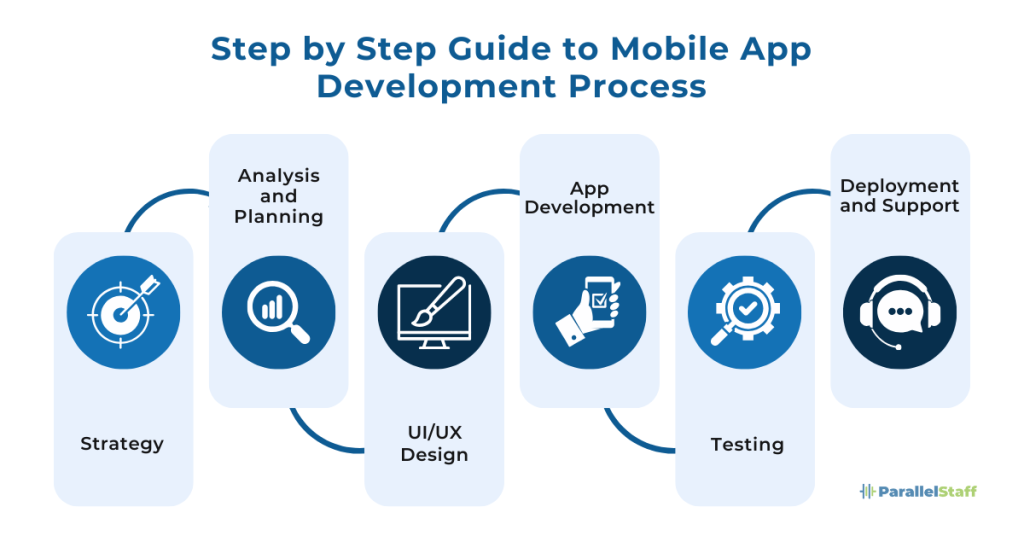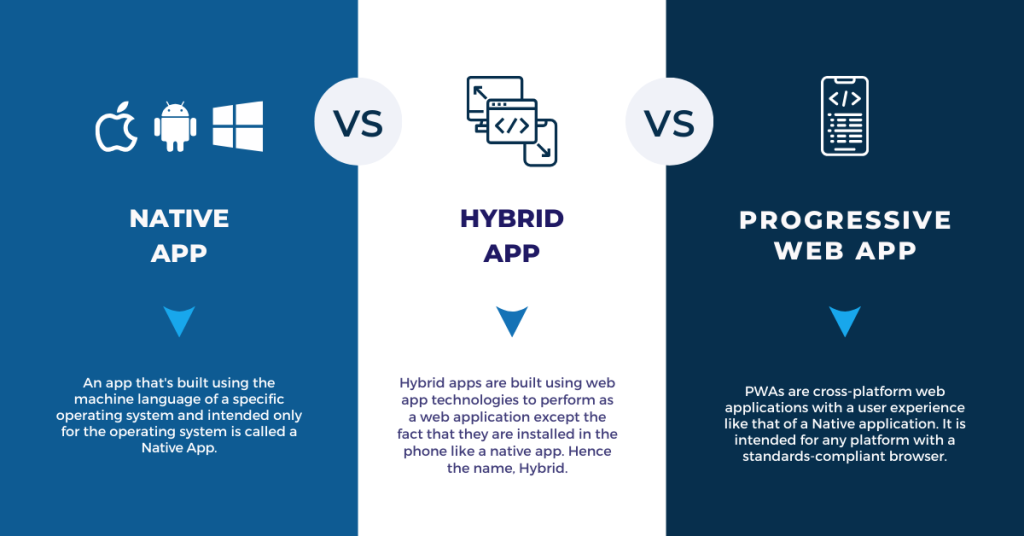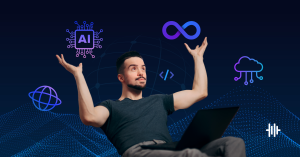Mobile applications have become crucial in everyday life, enabling consumer convenience and essential functionality across various industries. With smartphone usage rapidly expanding, businesses increasingly rely on mobile apps to improve accessibility, engagement, and market reach.

Basics of Mobile App Development
Mobile app development is designing software apps that operate on mobile devices and interact with remote computing resources via a network connection. The process begins with conception and then moves to design, development, and testing before being deployed in app stores.

Effective mobile app development necessitates extensive front-end and back-end technology knowledge and robust user interface and experience approaches.
Importance of Mobile App Development in Today’s Digital Age
In the current digital landscape, mobile apps are more than just convenient tools—they are necessary for businesses to stay competitive and relevant.
According to a recent report, users spend over 90% of their mobile time on apps, underscoring the shift towards app-based digital consumption. This trend points to the critical need for companies to adopt mobile-first strategies to effectively capture and engage their audience, thereby driving business growth and operational efficiency.
Understanding Different Types of Mobile App Development
The choice of app development type can considerably impact the application’s functionality, user experience, and maintenance. This article will look at the three primary forms of mobile app development: native, hybrid, and web-based. Each caters to different company goals and customer expectations.

Native App Development
Native apps are designed for specific platforms using their core programming languages and tools like Xcode for iOS or Android Studio for Android apps. For example, Pokémon Go, a highly interactive game, leverages native development to provide an optimized, platform-specific user experience that efficiently handles the device’s GPS and graphics hardware.
The primary advantage here is the seamless integration with the device’s features, offering superior performance and user experience. As per a report by Sensor Tower, top-performing native apps enjoy higher user retention rates than their hybrid counterparts.
Hybrid App Development
Hybrid apps are built using conventional web technologies such as HTML5, CSS, and JavaScript and wrapped in a native container that loads most of the information on the page as the user navigates the application.
Instagram is a prominent example of how HTML5 and a native framework can work together to manage rich media and notifications effortlessly. Hybrid apps benefit businesses that aim to cut development time and costs while launching across many platforms, including less popular mobile operating systems.
Instagram began as a native app for mobile users, but as it grew in popularity, Meta purchased it and integrated it into the Facebook network.
The move prompted Instagram to become more accessible and scalable. This resulted in Facebook redesigning Instagram to work in React Native, changing it into a hybrid app that allows users to store offline data and rich media.
Web-based App Development (Progressive Web App)
Web apps function like native apps but are accessed via a web browser on a mobile device. They are not standalone applications but websites that adapt their interface to the user’s device. Google Docs is a prime example, providing a comprehensive, app-like experience in a browser without the need for installation.
While web apps offer easier maintenance and cross-platform compatibility, they depend heavily on the quality of the internet connection and can provide limited functionality compared to native apps.
Exploring Platforms for Mobile App Development
Choosing the right platform is crucial as it directly influences the app’s reach, functionality, and development strategy. This section details the major platforms for mobile app development, highlighting their market reach, developer tools, and typical application scenarios.
Android App Development
Android dominates the global smartphone market with a share of about 71%. Its open-source nature provides developers with extensive customization features and a less restrictive app approval process than iOS. Popular apps like Spotify utilize Android’s broad market reach and Google’s flexible developer tools to offer a customizable user experience that is hard to replicate on other platforms.
iOS App Development
Although iOS has a smaller market share, its consumers are more likely to spend money on apps, making the platform more appealing for premium and in-app purchase-driven applications. iOS’s tight app review criteria ensure high-quality apps, as evidenced by Evernote, which provides comprehensive productivity features while maintaining optimal performance and security.

Cross-platform Development
Cross-platform tools like Flutter or React Native enable developers to write code once and deploy it on both Android and iOS platforms, which can significantly reduce development costs and time.
An example is Airbnb, which uses React Native to maintain a consistent user experience with minimal codebase divergence across platforms.

Role and Responsibilities of a Mobile App Developer
Mobile app developers are integral to the app development process, translating user and business needs into functional software. Their responsibilities span across various dimensions of app development:
- Design and Development: Creating a user-centric design and translating it into a fully functional application necessitates a thorough understanding of coding and design principles. For example, Uber’s smooth interface and responsive design are the product of rigorous programming and excellent design.
- Maintenance and Updates: After the app is launched, developers must ensure that it remains functional and relevant by providing regular updates and bug fixes, reacting to user input, and keeping up with changing market trends.
- Collaboration and Strategy: Developers frequently work in teams, collaborating with designers, product managers, and marketers to connect the app’s functionality with strategic business objectives.
A mobile app developer must possess diverse technical and soft skills to effectively design, build, and maintain mobile applications across various platforms. At the core, developers should have a solid understanding of programming languages specific to mobile environments. For native app development, knowledge of Swift or Objective-C is crucial for iOS, while Kotlin or Java is essential for Android platforms.
Many jobs will require a bachelor’s degree or similar to keep up with the demands of new technology (see later in this article).
Cross-platform developers often rely on languages like JavaScript along with frameworks such as React Native or Flutter to create apps that operate across iOS and Android from a single codebase.
Each role will necessitate additional skills such as UX design, API development, IDEs, and Git, as well as soft skills suited to the position’s level. Developers must also be adept at software development outsourcing to complete specific tasks or projects.
Steps in the Mobile App Development Process
Developing a mobile app involves several critical steps, each requiring meticulous attention to detail and strategic planning.
Idea Generation and Strategy
This initial phase involves brainstorming ideas, researching the market, and defining the target audience. Apps like Tinder have succeeded by addressing specific user needs and preferences, backed by robust market research and strategic positioning.
Designing UI/UX
Effective UI/UX design is crucial as it directly affects user retention and satisfaction. The design process includes wireframing, prototyping, and user testing, ensuring the app is intuitive and accessible. For example, Tinder’s intuitive swipe feature enhances user engagement through a simple, efficient user interface. You may need to consider hiring a dedicated team for software projects.
App Development
This is the time during which the app is built. Developers may use Swift, Kotlin, or JavaScript, depending on the platform. The development stage includes integrating many capabilities and ensuring the app runs well across all devices and operating systems.
Testing and Deployment
Testing is necessary to ensure that the software is free of flaws and issues. This step involves unit testing, integration testing, and acceptance testing to ensure that the program is resilient and reliable. After testing, the software is released to app stores for customer download.
Ongoing Maintenance and Updates
Following launch, the app requires regular updates to address problems, improve functions, and introduce new features based on user feedback and technical improvements. These updates keep the software competitive and relevant, keeping users interested and satisfied.
Challenges and Best Practices in Mobile App Development
Mobile app development has challenges, including handling device fragmentation, managing user data securely, and adhering to app store guidelines. Adopting best practices such as iterative testing, user feedback integration, and continuous learning can mitigate these challenges and enhance app quality.
Common Challenges
Device Fragmentation
Developing apps that offer consistent performance across an array of devices and OS versions. This issue is particularly pronounced in the Android ecosystem due to its open nature, which allows numerous manufacturers to offer devices with different levels of processing power, display resolutions, and software customizations.
Developers must test their applications extensively across multiple devices to guarantee a seamless user experience, often using tools like device farms or emulators to simulate different environments and ensure functionality and UI consistency.
User Privacy
Ensuring the app complies with global privacy regulations like GDPR. To align with these regulations, developers need to implement robust data protection measures, conduct regular privacy audits, and design apps with privacy in mind, ensuring that user data is handled securely and transparently throughout the app’s lifecycle.
App Store Approval
Navigating the app store approval process, particularly for platforms like iOS, requires a thorough understanding of the platform’s review guidelines, which are designed to ensure that all apps meet a high standard of quality and functionality. The iOS App Store, known for its stringent review standards, evaluates apps based on various criteria including security, user privacy, and the use of proprietary technologies.
Best Practices
Prioritize User Experience
Prioritizing user experience (UX) is crucial for the success of any mobile app. Apps like Instagram thrive because they offer intuitive and engaging interfaces that make navigation simple and enjoyable for users.
High-quality UX design should anticipate the user’s needs and preferences, making interactions seamless and reducing friction wherever possible. This involves thoughtful layout, aesthetic design, and interactive elements that are responsive and easy to use. By focusing on user satisfaction, apps can achieve higher retention rates, as satisfied users are more likely to return and engage with the app regularly, thereby driving sustained success.
Regular Updates
Regular updates are essential for maintaining user interest and satisfaction over time. They allow developers to introduce new features that respond to user feedback and evolving market trends, keeping the app relevant in a competitive landscape.
Updates also allow fixing bugs and improving overall app performance, which can enhance user experience and reduce churn. For instance, apps that frequently update their content or capabilities, such as mobile games that offer new levels or features, tend to maintain user engagement and extend the app’s lifespan in users’ devices.
Leverage Analytics
Using analytics tools is a key strategy for understanding how users interact with an app and identifying areas for improvement. Analytics can provide insights into user behavior, app performance, and engagement metrics, such as time spent, feature usage, and conversion rates.
This data is invaluable for making informed app updates, marketing strategies, and feature development decisions. By analyzing user activity and preferences, developers can tailor their offerings to meet the needs of their audience better, thus enhancing user satisfaction and driving business success.
Tools like Google Analytics for Mobile or Firebase provide robust frameworks for capturing and analyzing data from mobile apps.
Future Trends and the Changing Landscape
The mobile app development industry is rapidly evolving, influenced by emerging technologies like AI, machine learning, AR/VR, and the Internet of Things (IoT). These technologies are enhancing app capabilities and creating new opportunities for developers to innovate.
Impact of AI and Machine Learning
AI and machine learning are revolutionizing mobile apps by enabling more personalized user experiences through predictive analytics and intelligent automation. Apps like Replika use AI to interact with users conversationally, adapting to their emotional states and preferences.
The Rise of Augmented and Virtual Reality
AR and VR are transforming app experiences by offering immersive and interactive environments. Applications like IKEA Place allow users to visualize furniture in their space before purchasing, enhancing customer satisfaction and engagement.

Growth of IoT in Mobile Apps
IoT integration in mobile apps is enabling more interconnected and automated environments. Apps like Nest use IoT to allow users to control their home’s heating and cooling systems remotely, providing convenience and energy efficiency. Mobile app developers constantly require new technical skills to keep up with the technology and further their careers.
Conclusion: Key Takeaways for Hiring a Mobile App Developer
In today’s competitive digital landscape, developing a mobile app that meets high functionality standards, user engagement, and seamless performance is crucial for business success. As you consider the strategic hiring of a mobile app developer, choosing a partner who understands the technical demands and aligns with your business vision is essential. This is where ParallelStaff comes into play.
With over 500 successful software development projects and a pool of more than 5,000 top engineers from 15 countries, ParallelStaff offers the expertise and scale necessary to handle any mobile app development project. Our nearshore software development model ensures cost-effectiveness, cultural alignment, and real-time collaboration, making us a preferred partner for businesses seeking to innovate without compromise.
By entrusting your mobile app development to ParallelStaff, you benefit from a cohesive team of seasoned experts who have honed their skills in effective collaboration. We take complete ownership of the project lifecycle, from meticulous requirements analysis to the final delivery, ensuring every phase meets your expectations and our high standards.
Contact ParallelStaff today and let us help you drive your business forward with our trusted nearshore outsourcing solutions. Together, we can achieve outstanding results that resonate with your users and exceed your business objectives.
Schedule a call with ParallelStaff now to learn more about our services and how we can tailor them to your needs.






